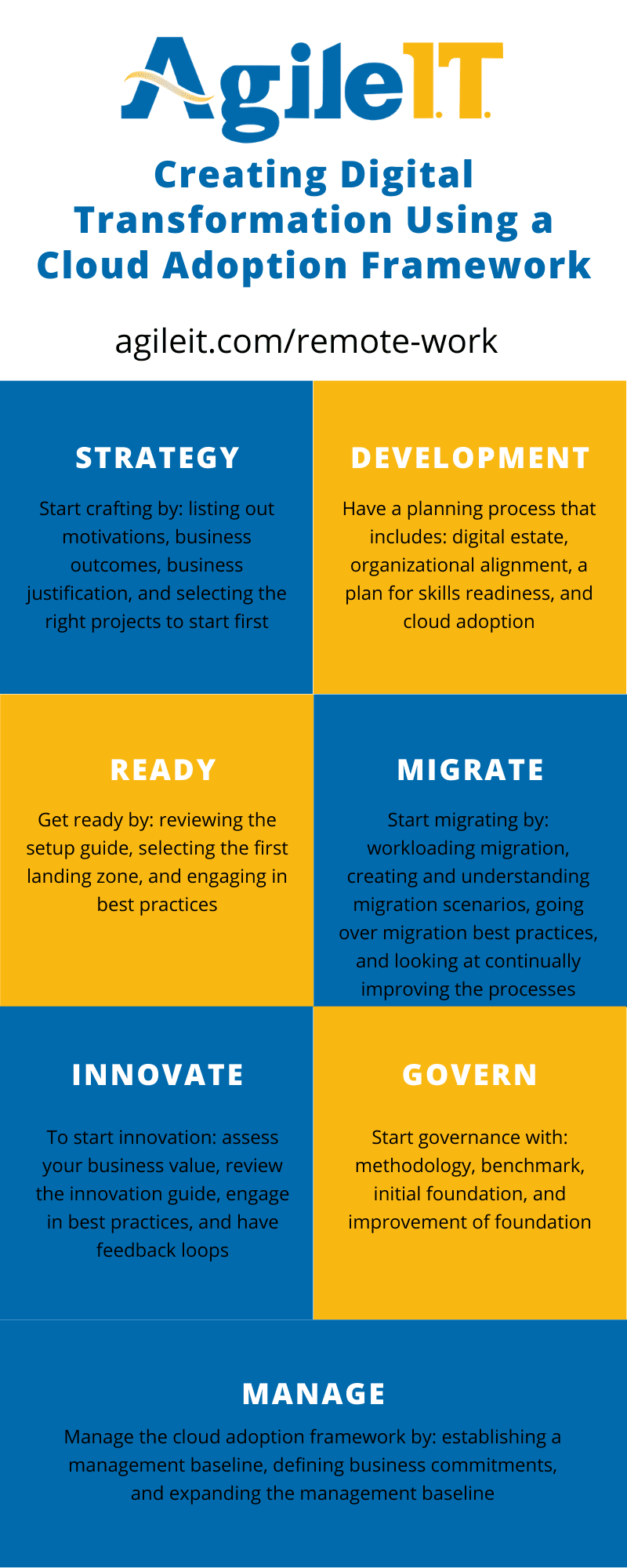Using The Cloud Adoption Framework
As a result of globalization more companies pursue digital transformation initiatives These help companies keep up with the everchanging technology...

As a result of globalization, more companies pursue digital transformation initiatives. These help companies keep up with the ever-changing technology for problem solving activities. One of the most common approaches to digital transformation is the adoption of cloud computing, which reduces reliance on hardware and, instead, increases reliance on cloud services paid through subscriptions. In some cases, digital transformation solutions help to enhance traditional software, whereas others are based entirely in the cloud. Over time, the cloud adoption framework was refined as the fastest, lowest risk and most efficient was to move to the cloud.
Since cloud service providers have guaranteed revenue in the form of subscriptions, they can finance development to the cloud with less risk. At the same time, digital transformations lead to improved efficiency through the use of automation, innovation, and creativity. While digital transformation occurs across the world, it’s not adopting at the same rate. For example, in relation to digital potential, in 2016, McKinsey found that Europe operated at 12%, whereas the United Kingdom was at 17%, which was close to the rate in the United States. It’s beneficial to participate in digital transformation. In fact, Agile IT can help with that using the cloud adoption framework (CAF).
Strategy
 Click to view the infographic
Click to view the infographic
As with most things that you do in business, developing a strategy should be a first course of action once the need is identified. The cloud is beneficial because there are fundamental technologies that will enable your enterprise to execute more than one strategy. Cloud-based approaches can help you improve your agility, productivity, and expansion capabilities into new markets. The business strategy you develop needs to be understandable for those working in the cloud environment and agreeable to your stakeholders. These steps involve understanding and documenting the following elements:
- Motivation. The first aspect for developing an effective strategy involves meeting with key stakeholders in order to determine the reasons and motivations that are driving cloud adoption.
- Business outcomes. The second aspect for developing an effective strategy involves meeting with key stakeholders to collaboratively document the planned business outcomes that may evolve from cloud adoption.
- Business justification. The third aspect for developing an effective strategy involves developing a business case that will allow for financial model validation to support the planned outcomes, which are based on motivations.
- Lastly, select the right project to do first. The fourth aspect to develop an effective strategy involves determining what cloud adoption project should be tackled first and will allow for the most appropriate motivation and technical effort alignment.
You can drive efforts at adoption that will capture business value using a cross-functional model, enabling you to effectively map your strategy to cloud capabilities that match the business strategies for meeting the digital transformation.
Development
The development of an appropriate cloud adoption plan for your company. These plans are designed to convert the goals of the strategy into actionable steps, leading to a specific outcome. It is possible to align technical efforts and business strategy through an appropriate plan. Further, the planning process involves completing prioritized tasks, leading to the metrics and motivation that was determined within the strategy. The planning process involves:
- Digital estate. The first aspect involves the rationalization and inventory of the company’s digital estate based on assumptions that are in alignment with your strategy.
- Organizational alignment. The second aspect involves aligning the organization to support cloud adoption.
- Plan for skills readiness. The third aspect involves preparing for gaps in readiness.
- Cloud adoption. The fourth aspect involves developing a plan allowing for effective management of change.
Indeed, by planning, you will be able to develop an effective strategy, which will help in the subsequent stages.
Ready
The next stage involves being ready. In this stage, you will be sure that your company is ready for the cloud adoption plan through the creation of a landing zone for hosting the workloads to be found in the cloud. The ready process involves the completion of landing zone exercises:
- Review the setup guide. First, you’ll want to review the setup guide so you’re familiar with the landing zone creation process, including its tools and approaches.
- Select the first landing zone. In this process, you’ll need to establish a code-based starting point through the selection of the most appropriate landing zone option for your company.
- Expand the landing zone. This involves meeting cloud adoption platform requirements.
- Lastly, engaging in best practices. This involves the validation of landing zone modifications using best practices for the proper configuration of all current and future landing zones.
This stage is important because it enables you to be prepared for your cloud adoption plan to be implemented successfully.
Migrate

The next stage involves migration. Cloud adoption plans typically include workloads that won’t warrant new business logic creation and, thus, move through multiple approaches, such as modernize, lift and shift, or lift and optimize. Then, the migration stage involves the following processes:
- First, workload migration. You’ll want to use the migration guide to familiarize yourself with native tools and approaches to migration.
- Creation and understanding of migration scenarios. You’ll need to leverage other migration tools and approaches in order to capitalize on different scenarios.
- Migration best practices. In this process, you’ll want to apply best practices to address common migration needs.
- Process improvements. It is recognized that the process of migration involves multiple activities that involves multiple processes. As these efforts scale, process improvements can be used for the evaluation and maturation of different migration aspects.
Innovate
The next stage involves innovation. Under this context, it is meant that all portfolios have workloads that may lead to a significant improvement in market position for the company. As most cloud adoption efforts are based on migration and modernization, innovation must be used to obtain most business value. Then, to do this, you should assess:
- Consensus of business value. Prior to deciding on technical solutions, it’s important that you determine how business value is driven by innovation, so it can be mapped to the cloud strategy.
- Review the innovation guide. You’ll want to review the innovation guide because there are multiple tools available to help you create a minimum viable product using basic tools.
- Engagement in best practices. As with other stages, you’ll want to follow best practices for all tools used in order to accelerate solution development.
- Feedback loops. The developed solutions offer ways for learning for employees and customers through feedback loop iterations. This means that the completion of fast and accurate feedback loops can help companies obtain better outcomes.
Govern
The next stage involves governance. This is important because the cloud creates new technological paradigms to support the business, which are influential in how the technologies are adopted, managed, and governed. Cloud governance involves iterative processes and cloud governance should complement any existing policies for company IT environments. The existing and cloud policy governance policy integration varies and is based on consistent changes throughout the cloud estate changes through the following steps:
- Methodology. You need to establish a basic cloud governance methodological understanding in the cloud adoption framework.
- Benchmark. You need to assess your current and future state to determine how to apply the cloud adoption framework.
- Initial foundation. You need to develop a small set of governance tools.
- Lastly, improvement of the foundation. As you implement the cloud adoption plan, add governance controls to address risks.
Indeed, these steps help in the advancement of the cloud adoption plan by assessing how it can be governed effectively.
Manage
The next stage involves management of the cloud adoption framework. Not only must you plan for, get ready for, and adopt the framework, you must also engage in ongoing activities for the digital assets for the delivery of tangible outcomes. Thus, the solutions must be reliable and well-managed. The business and technical approaches develop by:
- Establishing a management baseline. This involves developing all definitions for all management aspects, such as cloud management tools, processes, and criticality classifications for the delivery of minimum commitment.
- Defining business commitments. This involves documenting workloads that support establishing business and cloud management investments.
- Expand the management baseline. This involves determining best practices for cloud management tooling implementation.
Learn More About Implementing a Cloud Adoption Framework
Agile IT has successfully migrated over 2 million accounts and over 10 petabytes of data to the cloud. Thus, if you’re thinking about making the move to the cloud or are already there and want to know what happens next, contact us.





